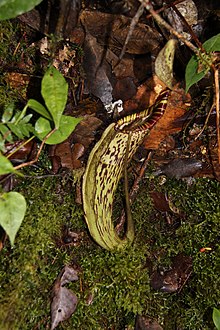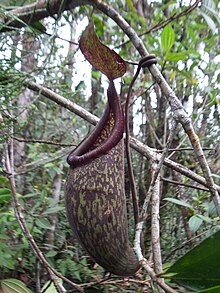顯目豬籠草
| 顯目豬籠草 | |
|---|---|

| |
| 顯目豬籠草的上位籠 | |
| 科學分類 | |
| 界: | 植物界 Plantae |
| 演化支: | 維管束植物 Tracheophyta |
| 演化支: | 被子植物 Angiosperms |
| 演化支: | 真雙子葉植物 Eudicots |
| 目: | 石竹目 Caryophyllales |
| 科: | 豬籠草科 Nepenthaceae |
| 屬: | 豬籠草屬 Nepenthes |
| 種: | 顯目豬籠草 N. spectabilis
|
| 二名法 | |
| Nepenthes spectabilis Danser (1928)
| |
| 異名 | |
顯目豬籠草(學名:Nepenthes spectabilis)是蘇門答臘特有的熱帶食蟲植物[1],生長於海拔1400至2200米的地區。其種加詞「spectabilis」來源於拉丁文,意為「顯著的,引人注目的」。[2]
植物學史
[編輯]
1920年6月5日,朱利葉斯·奧古斯特·魯爾金(Julius August Lörzing)在詩巴甲山(Mount Sibajak)海拔1800米至1900米處首次採集了顯目豬籠草的標本。該標本編號為「Lörzing 7308」,其與兩份含雄性和雌性花序的等模標本一起存放於茂物植物園。第三幅等模標本編號為「sheet H.L.B. 928.350-170」[3],存放於萊頓的荷蘭國家植物標本館中。[2][4]
1921年,朱利葉斯·奧古斯特·魯爾金又採集了兩份顯目豬籠草的標本。[注 1]穆罕默德·努爾·本·穆罕默德·高斯(Mohamed Nur bin Mohamed Ghose)在同一年的晚些時候採集了第四份標本。[注 2][4]
B·H·丹瑟在其1928年出版的開創性專著《荷屬東印度群島的豬籠草科植物》中正式描述了[注 3]顯目豬籠草。[4]他指定「Lörzing 7308」號標本為模式標本。B·H·丹瑟寫道:[注 4][4]
| “ | 該物種僅存在於同一座山脈的兩座山頂上——平托山和詩巴甲山;在塞邁克山上的也肯定屬於同一個類群。顯目豬籠草生長於海拔1800米以上的地區;其原生地為高山森林和灌木叢。因其與血紅豬籠草的營養組織較為相似,它們與血紅豬籠草之間似乎存在着密切的近緣關係,但花序上仍有些顯著的不同。
魯爾金認為其編號為「Lörzing 8297」的標本為雌雄同株;但標本中並沒有同時存在雄性和雌性花序的枝條,所以我對這點描述表示質疑。 |
” |
1986年,羅斯朱迪·塔明(Rusjdi Tamin)和堀田滿在他們的專著《蘇門答臘的豬籠草》(Nepenthes of Sumatra)中再次對顯目豬籠草進行了分類處理。[5]
一篇由布魯斯·李·貝德納爾(Bruce Lee Bednar)發表於1987年的一期《食蟲植物通訊》的文章中提到了在園藝貿易中存在一種叫做顯目豬籠草的植物。[6]植物學家簡·斯洛爾(Jan Schlauer)認為這種植物實際上是柯蒂斯豬籠草(N. curtisii),而柯蒂斯豬籠草現被認為是大豬籠草(N. maxima)的一個同物異名。[7]
在馬修·傑布和馬丁·奇克1997年在《豬籠草屬(豬籠草科)的框架性修訂》中,將熔岩豬籠草(N. lavicola)歸入了顯目豬籠草中。他們指定「Lörzing 7308」號標本為顯目豬籠草的選模標本。[8]但隨後,查爾斯·克拉克又在其專著中將熔岩豬籠草獨立了出來。[2]
形態特徵
[編輯]
顯目豬籠草為藤本植物。其莖為圓柱形,可長達6米,直徑可達7毫米。節間距可長達10厘米。[2]
顯目豬籠草的葉片革質,無柄,為長圓形,可長達16厘米,寬至6厘米。葉尖圓至急尖,漸狹至基部。中脈兩側的縱脈可多達6根。羽狀脈通常不明顯。籠蔓可長達25厘米。[2]
顯目豬籠草的下位籠的下三分之一至二分之一為窄卵形。籠肩以上為圓柱形,偶爾縮窄。其下位籠的體型都比較小,可高達12厘米,寬至4厘米。腹面具一對可寬達4毫米的籠翼。卵形部對應的內表面覆蓋着腺體[2],蠟質區極其發達[9]。籠口為圓形,前部扁平,傾斜至籠蓋。唇為圓柱形,可寬達4毫米。其內緣具許多小型但明顯的唇齒。[2]唇內緣部分約占截面表面總長度的41%。[9]籠蓋為橢圓形,無附屬物,基部為心形。籠蓋基部後方的籠蔓尾不分叉,可長達30毫米。[2]
顯目豬籠草的上位籠的下二分之一至三分之四為窄漏斗形。籠肩以上為圓柱形或在漏斗形。上位籠的體型要大於下位籠,高可達26厘米,可寬至4.5厘米。[4]籠翼縮小為一對隆起,但在靠近唇處仍可能具有翼須。上位籠籠肩以下的內表面覆蓋着腺體。籠口為圓形,極傾斜。唇為圓柱形,可寬達3毫米。上位籠其餘特徵類似於下位籠。[2]
顯目豬籠草的花序為總狀花序。總花梗可長達12厘米。花序軸可長達15厘米,但雌性花序的通常更短更密集。部分花梗具小苞片,帶兩朵花。萼片為橢圓形,可長達5毫米。[2]
顯目豬籠草被毛的發達程度有很高的可變性。大多數植株發育中的組織都覆蓋着紅褐色的星狀短毛被,但多數早落。花序及葉片的邊緣具有密集的紅棕色星狀持久毛被。葉片中脈的下表面也會覆蓋着密集的持久短毛被。[2]
顯目豬籠草的莖和葉片為綠色。捕蟲籠為綠色,並具有許多暗棕色的斑點。唇通常為淡黃綠色,並具有褐色的條紋。[2]
生態關係
[編輯]顯目豬籠草是印度尼西亞北蘇門答臘省和亞齊省特有的熱帶食蟲植物。其水平分布範圍南至多巴湖地區,北至凱米利山(Mount Kemiri)。海拔分布範圍從1400米至2200米。顯目豬籠草生長於苔蘚森林及矮小的高地山地森林中。其通常陸生,但也可附生。[2][10][11]
顯目豬籠草的某些種群的形態特徵差異較大。模式產地植株的上位籠較為寬達,而產自潘丘盧保山的較窄。在多巴湖的西側曾記錄到一種特別細長的變型。產自Siluatan山的捕蟲籠通體全綠。此外,該物種的毛被也表現出很高的可變性;部分植株披被着密集的毛被,而其餘幾乎無毛。[2][10]
產自本達哈拉山(Mount Bandahara)的顯目豬籠草變型具有非常巨大且異常平展的唇。其生長於泥炭蘚上。1996年,保羅·哈伍德、海科·里舍(Heiko Rischer)和安德烈亞斯·維斯圖巴觀察到該變型的上位籠及下位籠的主要獵物中包括了甲蟲。他們也在捕蟲籠內發現了共生蚊類的幼蟲。[12]
在野外,顯目豬籠草與杏黃豬籠草(N. flava)[13]、裸瓶豬籠草(N. gymnamphora)、邁克豬籠草(N. mikei)、卵形豬籠草(N. ovata)、菱莖豬籠草(N. rhombicaulis)和硬葉豬籠草(N. rigidifolia)同域分布。除杏黃豬籠草外,其他所有豬籠草物種與顯目豬籠草的自然雜交種都已被發現。[2][13][14]
由於顯目豬籠草呈片狀分布,所以其已被列入《2006年世界自然保護聯盟瀕危物種紅色名錄》中,保護狀況為易危。[15]1995年,查爾斯·克拉克在潘丘盧保山對顯目豬籠草的考察後寫道:「感覺盜採者已經采走了不少植株,部分地區很難見到幼年的植株」。[16]
相關物種
[編輯]
顯目豬籠草被認為與熔岩豬籠草之間存在着最為密切的近緣關係。它們的區別在於,顯目豬籠草具有較小的花苞片、較長的果實和非常長且不分叉的籠蔓尾。[2]它們下位籠的形狀也不相同,熔岩豬籠草的下位籠為壺形至球形,而顯目豬籠草下位籠的下部為卵形,上部為圓柱形。此外,熔岩豬籠草的捕蟲籠一般通體為暗棕色或紫色,而顯目豬籠草為淺綠色,且具有深褐色的斑點。[3]
查爾斯·克拉克的《蘇門答臘島與西馬來西亞的豬籠草》一書中曾提及了一種產自亞齊省的未描述類群,其表現為熔岩豬籠草和顯目豬籠草的中間型。因其沒有與其他任何豬籠草物種同域分布,所以不太可能起源於雜交種。[2]
硬葉豬籠草也與顯目豬籠草有些許相似,特別是捕蟲籠的顏色。[2]除了它們的上位籠有着顯著的不同外,顯目豬籠草的葉片更薄、籠蔓尾不分叉並且籠蔓從葉尖伸出。[17]
在B·H·丹瑟1928年的專著中,顯目豬籠草被歸入高貴分支(Nobiles)。他寫道:[注 5][4]
| “ | 第三組,即高貴分支,包含了普通分支和山地分支兩分支與皇室分支之間的過渡物種。產自蘇門答臘的顯目豬籠草在許多方面都讓人聯想到血紅豬籠草,但其乾燥標本為黃色,且具有紅棕色的毛被也表現出與皇室分支之間存在相似性。 | ” |
查爾斯·克拉克認為「將顯目豬籠草歸入山地分支可能會更好,因其中包含了幾種與之存在着密切近緣關係的物種,如裸瓶豬籠草和梳狀豬籠草(N. pectinata)」。[2]
2001年,查爾斯·克拉克發表了一份對來自蘇門答臘島和西馬來西亞的豬籠草進行了分支系統學分析,共利用了70個形態特徵。由此得到的進化樹中,顯目豬籠草與裸瓶豬籠草一起被歸入了一個小分支中。然而,由於該研究在地理範圍上的局限,其分析的地域可能無法準確反應顯目豬籠草與其密切相關的物種之間的關係。[2]
自然雜交種
[編輯]顯目豬籠草與其他許多豬籠草屬物種同域分布,並已記錄到了大量自然雜交種。[2]
卵形豬籠草與顯目豬籠草的自然雜交種
[編輯]現已知卵形豬籠草與顯目豬籠草的自然雜交種(N. ovata × N. spectabilis)存在於潘丘盧保山的頂峰山徑。該自然雜交種的捕蟲籠呈現出親本的中間型。其唇平展,寬大,但不如卵形豬籠草的唇發達。其繼承了顯目豬籠草捕蟲籠的斑點,但顏色要淺得多。該自然雜交種的大部分植株都陸生,少數附生於林冠。[2]
硬葉豬籠草與顯目豬籠草的自然雜交種
[編輯]在硬葉豬籠草的模式產地附近的一塊開闊的亂石區發現了幾株硬葉豬籠草與顯目豬籠草的自然雜交種(N. rigidifolia × N. spectabilis)。該自然雜交種與硬葉豬籠草的區別在於,其捕蟲籠較窄,基部為漏斗形且中部具明顯的籠肩。另一方面,其捕蟲籠又寬於顯目豬籠草,唇也較寬大。[2]
硬葉豬籠草與顯目豬籠草的自然雜交種下位籠的顏色很豐富,其表面上與麥克法蘭豬籠草(N. macfarlanei)也有幾分相似。但是麥克法蘭豬籠草僅存在於西馬來西亞,所以這兩個類群並不容易混淆。[2]
其他自然雜交種
[編輯]此外,還發現了其他四種顯目豬籠草的自然雜交種。分別為裸瓶豬籠草與顯目豬籠草的自然雜交種(N. gymnamphora × N. spectabilis)、邁克豬籠草與顯目豬籠草的自然雜交種(N. mikei × N. spectabilis)、菱莖豬籠草與顯目豬籠草的自然雜交種(N. rhombicaulis × N. spectabilis)和顯目豬籠草與多巴豬籠草的自然雜交種(N. spectabilis × N. tobaica)。[2]
注釋
[編輯]- ^ 1921年1月22日,在平托山(Mount Pinto)山頂附近海拔2100至2200米的地區採集到了編號為「Lörzing 8260」的標本。其包含雄性花序,存放於茂物植物園中。一幅可能的副本存於荷蘭國家植物標本館中,其也包含雄性花序。[4]
1921年1月23日,在詩巴甲山(Mount Sibajak)山頂附近海拔1900米的地區採集到了編號為「Lörzing 8297」的標本。其包含雄性及雌性花序,存放於茂物植物園中。[4] - ^ 1921年8月5日,在塞波蘭吉(Sibolangit)附近的塞邁克山(Bukit Semaik)採集到了編號為「Nur 7342」的標本。其不含花序,存放於新加坡植物園中。[4]
- ^ 顯目豬籠草的原拉丁文描述如下:[4]
“ Folia mediocria sessilia v. petiolo late alato, lamina oblonga-spathulata, nervis longitudinalibus utrinque 5-6, basi rotundata v. leviter cordata caulis 2/3-3/4 amplectente, vagina 0, ascidia rosularum et inferiore ignota ; ascidia superiore magna, e parte inferiore anguste infundibuliformi tubulosa ; costis 2 prominentibus ad os appendice folicea ramosa ornatis ; peristomio operculum versus accuminato, vix in collum elongato applanato, 3-12 mm lato, costis 3/4-1 mm distantibus, dentibus 3-5 x longioribus quam latis ; operculo rotundato-cordato, facie inferiore plano v. obtusa-cordato inflorescentia racemus pedicellis 10-3 mm longis plerumque 2-floris ; indumentum parcum villoso-tomentosum, ferrugineum. ” - ^ B·H·丹瑟在其1928年出版的開創性專著《荷屬東印度群島的豬籠草科植物》中關於顯目豬籠草論述的原文:[4]
“ The third group, that of the Nobiles, comprises the species that form a transition between the Vulgatae and the Montanae on one hand and the Regiae on the other. N. spectabilis, from Sumatra, reminds one of N. sanguinea in many respects but shows a resemblance with the Regiae by the yellowish colour of herbarium specimens and by the red-brown indumentum. ” - ^ B·H·丹瑟在《荷屬東印度群島的豬籠草科植物》對顯目豬籠草分類的論述原文:[4]
“ This new species has only been found on the G. Sibajak and the G. Pinto, two tops of the same mountain ; the Bt. Semaik too certainly belongs to the same group. N. spectabilis grows above 1800 m elevation ; the habitat is alpine forest and scrub. It seems to be most closely related to N. sanguinea by the characters of the vegetative parts, but the inflorescences are quite different
Lörzing says of his number 8297 that it was a monoeceous sic plant ; since, however, in H. B. there is no stem fragment both with male and female flowers, I call this record into question.”
參考文獻
[編輯]- ^ 夏洛特. 食蟲植物觀賞&栽培圖鑑. 台北: 商周出版. 2007: 77. ISBN 978-986-124-850-9.
- ^ 2.00 2.01 2.02 2.03 2.04 2.05 2.06 2.07 2.08 2.09 2.10 2.11 2.12 2.13 2.14 2.15 2.16 2.17 2.18 2.19 2.20 2.21 2.22 2.23 2.24 Clarke, C.M. 2001. Nepenthes of Sumatra and Peninsular Malaysia.Natural History Publications (Borneo), Kota Kinabalu.
- ^ 3.0 3.1 Wistuba, A. & H. Rischer 1996. Nepenthes lavicola, a new species of Nepenthaceae from the Aceh Province in the North of Sumatra (頁面存檔備份,存於網際網路檔案館). Carnivorous Plant Newsletter 25(4): 106–111.
- ^ 4.00 4.01 4.02 4.03 4.04 4.05 4.06 4.07 4.08 4.09 4.10 4.11 Danser, B.H. 1928. The Nepenthaceae of the Netherlands Indies. Bulletin du Jardin Botanique de Buitenzorg, Série III, 9(3–4): 249–438.
- ^ Tamin, R. & M. Hotta 1986. Nepenthes di Sumatera: The genus Nepenthes of the Sumatra Island. In: M. Hotta (ed.) Diversity and Dynamics of Plant Life in Sumatra 1. Kyoto University, Japan. pp. 75–109.
- ^ Bednar, B.L. 1987. Old Clone, New Hybrid.PDF (405 KiB) Carnivorous Plant Newsletter 16(3): 69–70.
- ^ Schlauer, J. 2006. Nepenthes spectabilis (頁面存檔備份,存於網際網路檔案館). Carnivorous Plant Database.
- ^ Jebb, M.H.P. & M.R. Cheek 1997. A skeletal revision of Nepenthes (Nepenthaceae). Blumea 42(1): 1–106.
- ^ 9.0 9.1 Bauer, U., C.J. Clemente, T. Renner & W. Federle 2012. Form follows function: morphological diversification and alternative trapping strategies in carnivorous Nepenthes pitcher plants. Journal of Evolutionary Biology 25(1): 90–102. doi:10.1111/j.1420-9101.2011.02406.x
- ^ 10.0 10.1 Hopkins, M., R. Maulder & B.[R.] Salmon 1990. A real nice trip to Southeast Asia.PDF (1.72 MiB) Carnivorous Plant Newsletter 19(1–2): 19–28.
- ^ McPherson, S.R. & A. Robinson 2012. Field Guide to the Pitcher Plants of Sumatra and Java. Redfern Natural History Productions, Poole.
- ^ Harwood, P., H. Rischer & A. Wistuba 1998. The carnivorous flora of Gunung Bandahara (頁面存檔備份,存於網際網路檔案館). Carnivorous Plant Newsletter 27(2): 59–61.
- ^ 13.0 13.1 Wistuba, A., J. Nerz & A. Fleischmann 2007. Nepenthes flava, a new species of Nepenthaceae from the northern part of Sumatra (頁面存檔備份,存於網際網路檔案館). Blumea 52(1): 159–163.
- ^ Salmon, B.R. & R.G. Maulder 1995. Two New Species of Nepenthes from North Sumatra, Indonesia (頁面存檔備份,存於網際網路檔案館). Carnivorous Plant Newsletter 24(3): 77–85.
- ^ Clarke, C.M., R. Cantley, J. Nerz, H. Rischer & A. Witsuba 2000. Nepenthes spectabilis. 2006 IUCN Red List of Threatened Species. IUCN 2006. Retrieved on 11 May 2006. Listed as Vulnerable (VU D2 v2.3).
- ^ Clarke, C.[M.] 1997. Another Nice Trip to Sumatra (頁面存檔備份,存於網際網路檔案館). Carnivorous Plant Newsletter 26(1): 4–10.
- ^ Akhriadi, P., Hernawati & R. Tamin 2004. A new species of Nepenthes (Nepenthaceae) from Sumatra. 網際網路檔案館的存檔,存檔日期2016-03-04. Reinwardtia 12(2): 141–144.
- Bonhomme, V., H. Pelloux-Prayer, E. Jousselin, Y. Forterre, J.-J. Labat & L. Gaume 2011. Slippery or sticky? Functional diversity in the trapping strategy of Nepenthes carnivorous plants. New Phytologist, published online on March 24, 2011. doi:10.1111/j.1469-8137.2011.03696.x
- Clarke, C.M. 2006. Introduction. In: Danser, B.H. The Nepenthaceae of the Netherlands Indies. Natural History Publications (Borneo), Kota Kinabalu. pp. 1–15.
- Danser, B.H. 1928. 42. Nepenthes spectabilis DANS., spec. nova. (頁面存檔備份,存於網際網路檔案館) In: The Nepenthaceae of the Netherlands Indies. Bulletin du Jardin Botanique de Buitenzorg, Série III, 9(3–4): 249–438.
- (印尼文) Dariana 2010. Keanekaragaman Nepenthes dan pohon inang di Taman Wisata Alam Sicikeh-Cikeh Kabupaten Dairi Sumatera Utara (頁面存檔備份,存於網際網路檔案館). M.Sc. thesis, University of North Sumatra, Medan.
- Harwood, P. & S. Lumb 1998. Nepenthes spectabilis on Gunung Sinabong. The Carnivorous Plant Society Journal 21: 62–63.
- Hernawati & P. Akhriadi 2006. A Field Guide to the Nepenthes of Sumatra. PILI-NGO Movement, Bogor.
- (印尼文) Mansur, M. 2001. Koleksi Nepenthes di Herbarium Bogoriense: prospeknya sebagai tanaman hias.PDF In: Prosiding Seminar Hari Cinta Puspa dan Satwa Nasional. Lembaga Ilmu Pengetahuan Indonesia, Bogor. pp. 244–253.
- Meimberg, H., A. Wistuba, P. Dittrich & G. Heubl 2001. Molecular phylogeny of Nepenthaceae based on cladistic analysis of plastid trnK intron sequence data. Plant Biology 3(2): 164–175. doi:10.1055/s-2001-12897
- Meimberg, H. & G. Heubl 2006. Introduction of a nuclear marker for phylogenetic analysis of Nepenthaceae. Plant Biology 8(6): 831–840. doi:10.1055/s-2006-924676
- Meimberg, H., S. Thalhammer, A. Brachmann & G. Heubl 2006. Comparative analysis of a translocated copy of the trnK intron in carnivorous family Nepenthaceae. Molecular Phylogenetics and Evolution 39(2): 478–490. doi:10.1016/j.ympev.2005.11.023
- Renner, T. & C.D. Specht 2011. A sticky situation: assessing adaptations for plant carnivory in the Caryophyllales by means of stochastic character mapping. International Journal of Plant Sciences 172(7): 889–901. doi:10.1086/660882
- (印尼文) Syamsuardi & R. Tamin 1994. Kajian kekerabatan jenis-jenis Nepenthes di Sumatera Barat. Project report, Andalas University, Padang. Abstract
- (印尼文) Syamsuardi 1995. Klasifikasi numerik kantong semar (Nepenthes) di Sumatera Barat. [Numerical classification of pitcher plants (Nepenthes) in West Sumatra.] Journal Matematika dan Pengetahuan Alam 4(1): 48–57. Abstract







